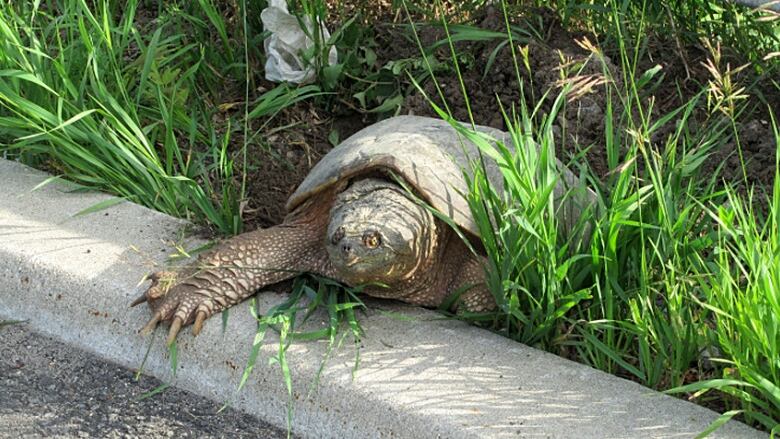How Hamilton's endangered turtles crossed the road
Officials are weighing options for 2016, including raised barriers and lower speed limits

It's an annual effortthat started about eight years ago dozens of volunteers walking up and down the roads in Dundas, helping turtles cross the road.
Each year, volunteers from Dundas Turtle Watchwalk in the grassy areas along Cootes Drive, Spencer Creek and King Street East. If they see a turtle inching toward the road, they don't turn it around, but they help it skip over the most dangerous part of the trip.
"You don't divert a turtle," said Joanna Chapman, co-founder of the group. "We help move it in the direction that it's been going."
Snapping turtles are the ones you have to watch out for because they have a very long neck.They're able to turn their head around and bite.- Joanna Chapman, Dundas Turtle Watch
This effort is just one of many that will continue this year as authorities and volunteers scramble to find ways to stopturtlessome of the species are endangeredfrom being crushed under the wheels of vehicles on Cootes Drive.
The city, Hamilton Conservation Authority (HCA) and Royal Botanical Gardens (RBG) will look at measures such as reducing speed limits, permanent fencing and barriers to prevent turtles from making it to the pavement. It plans "Turtle migration" signs to let motorists know when it's migrating season, and even moving the Dundas Community Garden, a preferred nesting spot for turtles.
Female turtle of various species endangered and otherwise cross the road from the marsheachJune, looking for a south-facing slope to lay their eggs. Often, the turtles are 20 or 30 years old, Chapman said, and their eggs are visible through the cracked shells of their corpses.
So Dundas Turtle Watch helps them. Commonly encountered species includethe midland painted turtle, snapping turtle, northern map turtle and Blanding's turtle. Each gets different treatment.

If it's a painted turtle, Chapman said, volunteerscan pick it up and carry it. If it's a snapping turtle, they have to coax it onto a large towel or sheet and carry it across the road that way.
"Snapping turtles are the ones you have to watch out for because they have a very long neck," Chapman said. "They're able to turn their head around and bite."
On Monday, Tys Theysmeyer, head of natural lands at the Royal Botanical Gardens (RBG), outlined some turtle-saving efforts for city councillors on the public works committee.
Here are some other ways local volunteers and officials are working to save the turtles:
1. Counting the dead
Dundas Turtle Watch has been working with HCA to mark down road kill fatalities not just turtles, but snakes, amphibians and mammals along Cootes Drive.The numbers are used to identify hot spots where road kill occurs, and where to focus efforts.
The majority of turtle deaths happen on CootesDrive along RBG lands heading from Dundas to the west end. Road kill counts in June and September 2015 were as follows:
- Turtles: 93
- Amphibians: 57
- Birds: 8
- Mammals: 5
- Snakes: 2
2. Putting up barriers to keep turtles from reaching the road
For the last two years, HCA put up a temporary silt fence along the Cootes Drive trail to prevent turtles from reaching the road, says a city report on Monday. The fence led turtles to two culverts under the road instead.
But this isn't a viable solution in the long term. The city and HCA will work this year to come up with a permanent solution, possibly in the form of a permanent fence along the south side of Cootes Drive.
A wildlife corridor subcommittee which includes the city, RBG, conservation authorities and Hamilton Naturalists Club is looking at other options too, includingraised barriers anda road underpass for small animals.
3. Slowing everybody down and "turtle crossing" signs
The city will look at reducing the speed limit, better signs and other traffic calming measures along Cootes Drive. Dundas Turtle Watch, the report says, is also looking at "Turtle migration" signs to let drivers know when it's migrating season.
The city alsoerects "Caution: Turtle crossing" signs each year to warn motorists, Chapman said.
4. Possibly moving the Dundas Community Garden
Officials are talking about possibly moving the Dundas Community Garden, the report says. Discussions are ongoing. The garden is located in a preferred nesting ground for turtles. In May, the RBG built two article turtle nesting beds on RBG property near the garden.
5. Improving the water quality
The RBG wants improved water quality in the Cootes Paradise marsh and the Old Desjardin Canal. Poor water quality hurts the aquatic ecosystem, the report says, and encourages non-native plants such as phragmites.
The city plans capital upgrades for the Dundas wastewater treatment plant, which will help Cootes Paradise. The city has also been trying to mitigate storm water contaminants. Other efforts to clean up the harbour, including covering the Randle Reef toxic sediment area and improving the Woodward Avenue wastewater treatment plan, will also help turtles.
Dundas Turtle Watch also has an emergency hotline (289-775-1351) to call if a turtle is in danger. It also plans a new brochure to distribute to city councillors, city staff and the public.












_(720p).jpg)


 OFFICIAL HD MUSIC VIDEO.jpg)
.jpg)



























































































